An artist capable of capturing the moistness of the air
Under a crisp autumn sky, beyond the layers of mountains I catch a glimpse of the unmistakable pointed peak of Mt.Yari jutting out. The elegant triangular pyramid is Mt. Kasagatake, while the grand mountain stretching out in front of that is Mt.Yakushi. Several sloping high plateaus come into view, and in the middle standing all alone is a mountain hut. Basking in the warm sunlight, I set down my rucksack and lie down. Facing upwards and closing my eyes, the dry wind delivers the fragrant scent of autumn plants.
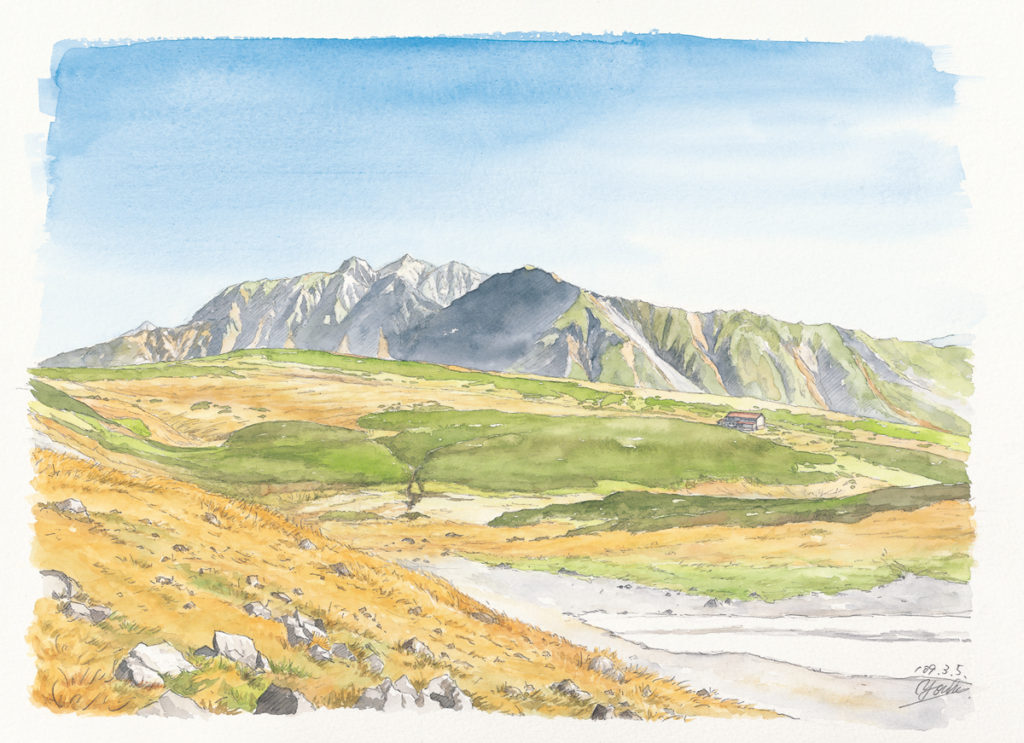
illustration | Yohei Naruse
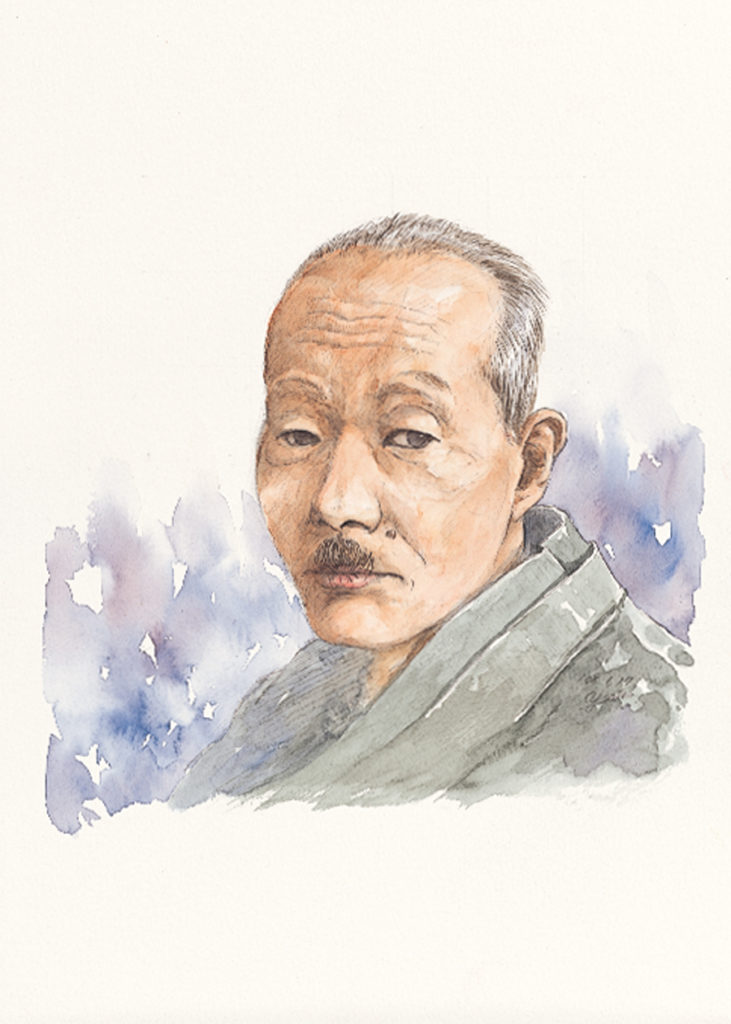
illustration | Yohei Naruse
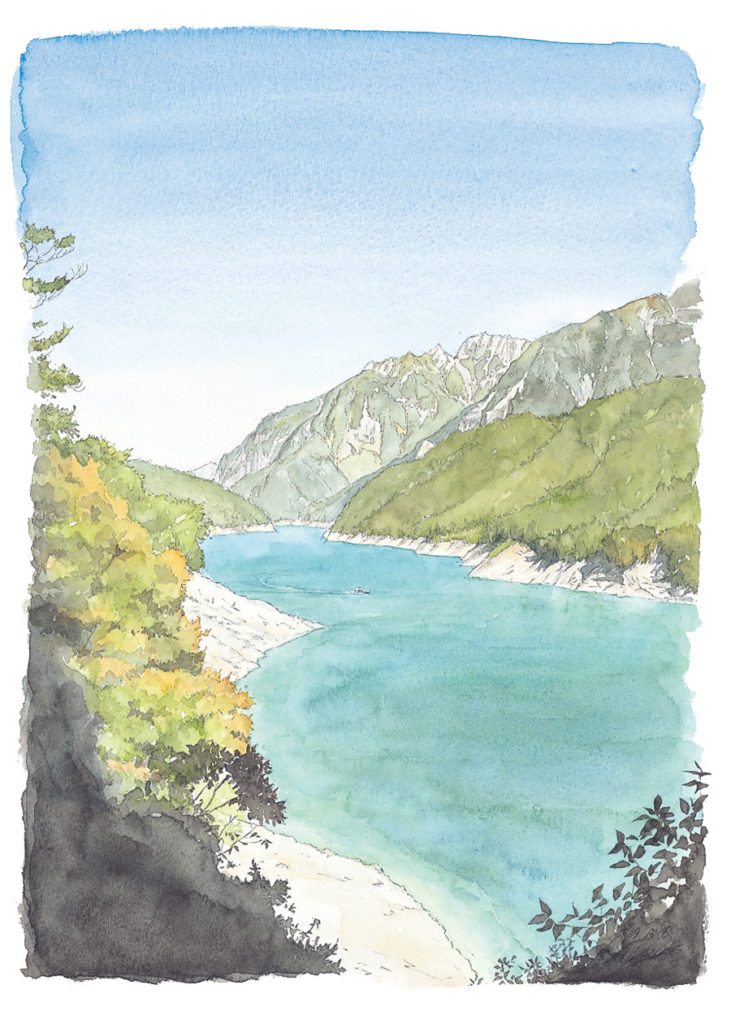
illustration | Yohei Naruse
Every winter, the moist wind that prevails across the Sea of Japan collides with the towering Tateyama range and deposits a huge amount of snow. This is what makes Kurobe an area of heavy snow fall, and explains why Goshikigahara is still cloaked in a wall of snow in late June. Once summer comes and the monumental snowmelt creates a marshland, the plateaus become another world full of alpine plants blooming in profusion. What follows was written by Hiroshi Yoshida.
“Much as there are very few lakes in the Japan Alps, there are even fewer plateaus. There are some that spring to mind such as Goshikigahara in between Oomachi and Tateyama, but even there cannot be said to be a plateau with a flat surface. This alpine zone land is undulating and festooned with black Pinus pumila trees, and in fact it is the part nearer to Mt.Yakushi that is easier on the eye. When I recall the lingering snow at Goshikigahara, the part nearer Mt.Yakushi is resplendent with the blooming of small mountain flowers and is very much reminiscent of the inner plateau of a high mountain”.
The lingering snow and the sprawling plateau described here is what is depicted in Yoshida’s “Goshikigahara”. However, the most impressive feature of this work is surely the evening sun tinged with a faint hue and seeped in the clouds that suddenly appear from nowhere.
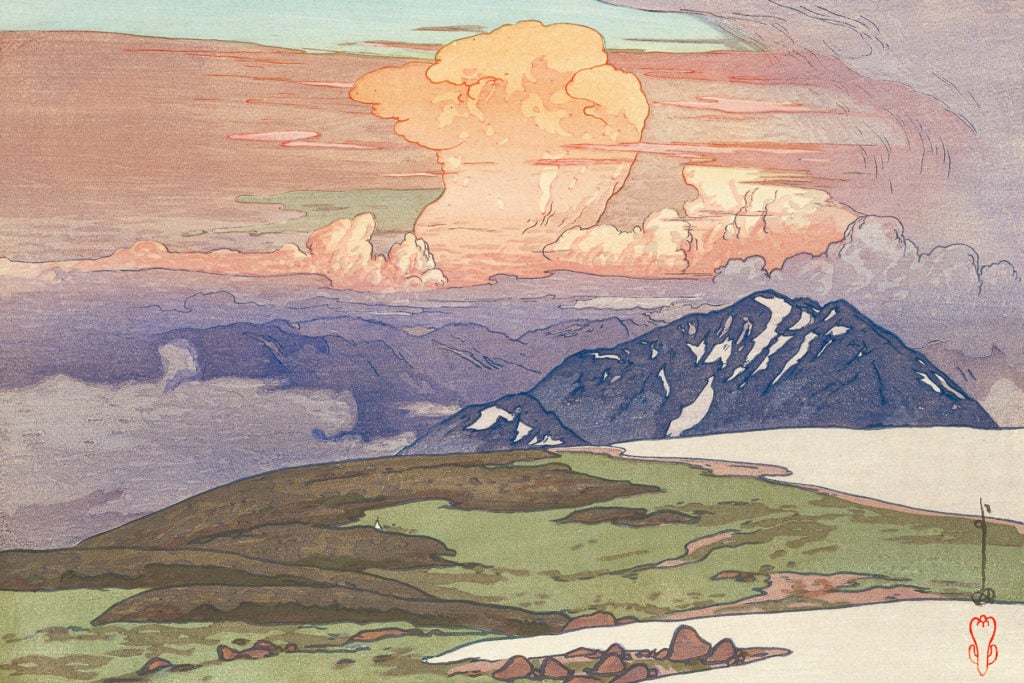
I am awoken by the sensation of the wind brushing against my face. Strong sunlight reflects off a radiant sea of clouds which are almost dazzling. Far away in the distance I can just about discern the form of Mount Haku. Following the gentle path over the bare surface of the mountain and having traversed the plateau I descend a steep slope to Zaratōge pass. Once past three o’clock, the wind starts to feel chilly. Scaling the final hill bathed in golden sunlight, I find myself in a voluminous plateau. I have reached Goshikigahara.
The floral bloom has peaked, the grass a dark brown color as if preparing for winter. Having finished flowering, the ubiquitous Geum pentapetalum bear seed-heads much like cotton. Basking in the sunlight from the west, they sparkle intensely as if shedding reserves of saved-up light. A gentle breeze blows across the plateau, through which runs a single wooden path beyond which I glimpse the red roof of the Goshikigahara Hut. A chat with the owner reveals that the mountain depicted in the middle right of “Goshikigahara” is in fact Mt.Akaushi. While you can apparently make out the spearhead of Mt.Yari on a clear day, Yoshida’s interests were more kindled in sketching the phantasmal welling-up of the clouds and capturing the ever-changing and ephemeral beauty of these lofty peaks.
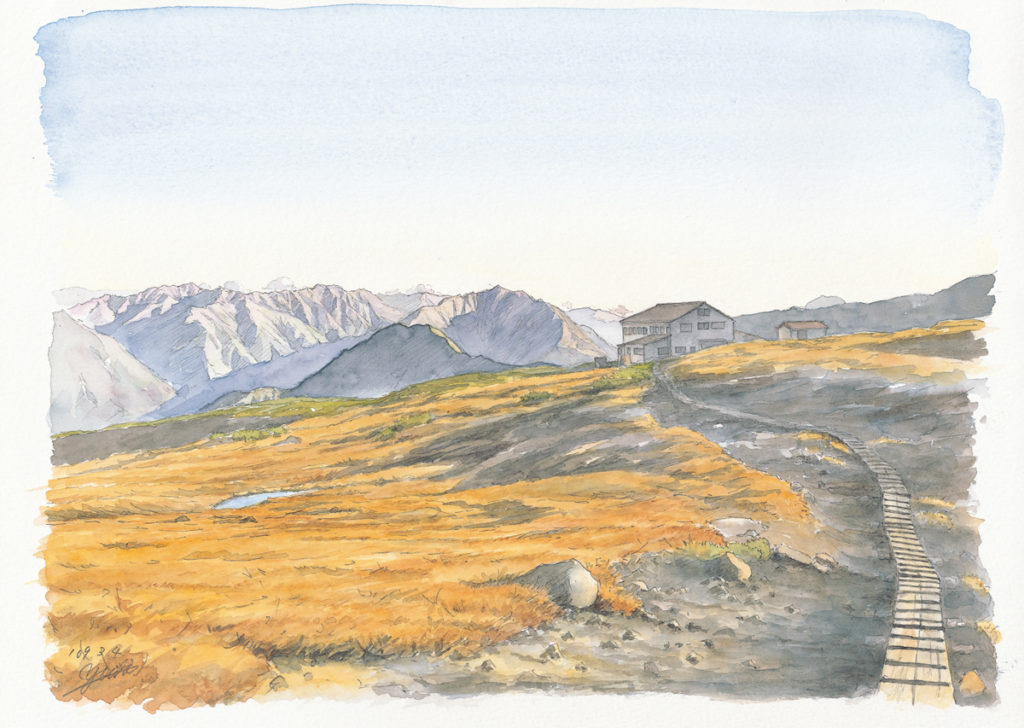
illustration | Yohei Naruse
Regarded as peerless when it came to depicting water scenes, Hiroshi Yoshida was able to harness his astounding descriptive powers to express not only water and moist air, but also the subtle movements of clouds and their colors. To quote: “There is a deep relationship between changes in the weather and the beauty of high mountains. Once you have some experience, you become able to detect what the weather is about to do through the sensation of the air on your skin. In that sense, you can also predict the weather from the colors of the mountain skies. When the weather is good, the colors are vivid to the point of being exhilarating. Before the weather turns, no matter how visible the mountains are in the distance and even if the sky is not clouding over, the sky takes on a dull hue. Similarly with fog, there is that which portends inclement weather and that which is a sign of clear skies on the way, and one must trust one’s own senses. In the case of fog that is a prelude to clear weather, even if the visibility is reduced in front of you, there is a vaguely perceptible brightness that pervades throughout”.
Yoshida secluded himself in the mountains and wandered around in a quest to sketch “the beauty of high mountains”, spending hours upon days waiting for those fleeting moments of beauty. While gazing at the crags and peaks, the skill he sought to hone most of all was capturing the changes in light and clouds. “While I have never gone into the mountains in search of fine weather, I feel an endless fascination for the spectacle provided by the magnificent scenery before and after a rainstorm”. True to these words, Yoshida refined his ability to profoundly perceive the subtle changes in the weather, lights, and colors, determined to express the splendid albeit ephemeral beauty of the mountain scenery.
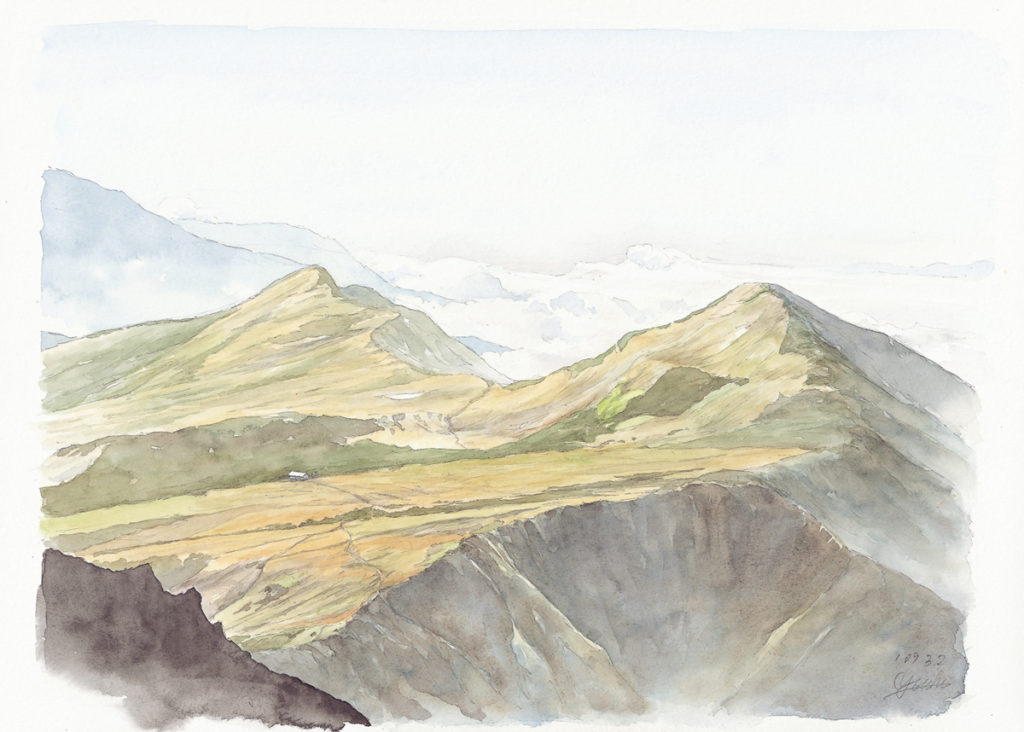
illustration | Yohei Naruse
The following day, a deep blue sky stretches all around. Under this cobalt and cloudless azure sky, I catch sight of a gently undulating carpet of olive-colored Pinus pumila trees and wilted grass that sparkles brilliantly against the morning sun.
After breakfast, I decide to explore the vicinity to try and pinpoint the vantage point from which Yoshida sketched “Goshikigahara”. Based on the shape of Mt.Akaushi and the relief of Goshikigahara, I deduce that it was right in the middle of the slope that goes all the way to Mt.Washi. There is no board walk, and it is now off limits to the hiker. Until a few decades ago, hikers would commonly take a nap under the stars, and Yoshida singles out Goshikigahara as a place for “aimlessly sprawling out on the grassland, gazing at mountains and drawing pictures”. He probably whiled away many pleasant hours up here.
I follow the boardwalk up to a point that affords a view of Goshikigahara from above. Perched on the ridge, I feel the wind blowing across from the west. Beyond the grasses dancing in the wind are the imposing peaks of the Tateyama range, casting their shadows against the morning sun.
<PAPERSKY no.29(2009)>
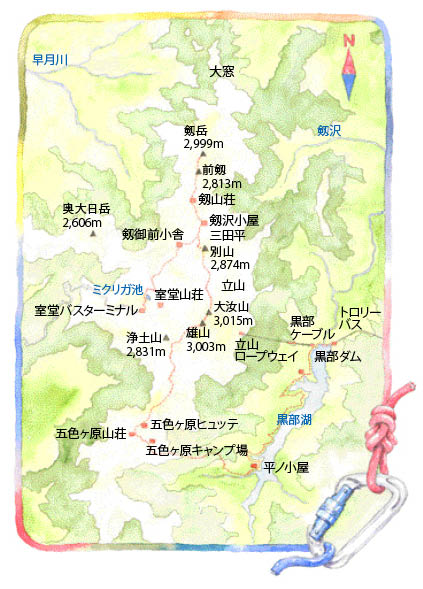
route information
Formed by the eruption of the former Tateyama volcano, the Goshikigahara plateau becomes another world during the summer, bursting with mountain flora and fauna. While there are some ladders to negotiate along the route from Tateyama to Goshikigahara, it is overall very walkable. However, snow tends to linger long after winter so proceed with caution and take basic crampons just in case. For this trip, I walked past Tairano Hut and then down through the Kurobe Dam, following the path etched into the slope that descends to the lake. While there are not many ups and downs, the course can take up to 3.5 hours and can partially collapse due to heavy rain, so it is best to confirm in advance before setting out. Instead of descending to Lake Kurobe, another great option is to follow the ridgeline from Goshikigahara over to Mt.Yakushi.
Yohei Naruse
Born in Gifu Prefecture in 1982. Graduated Tsuru University, Graduate School. Following a stint in advertising, he currently works as a freelance writer and illustrator.











